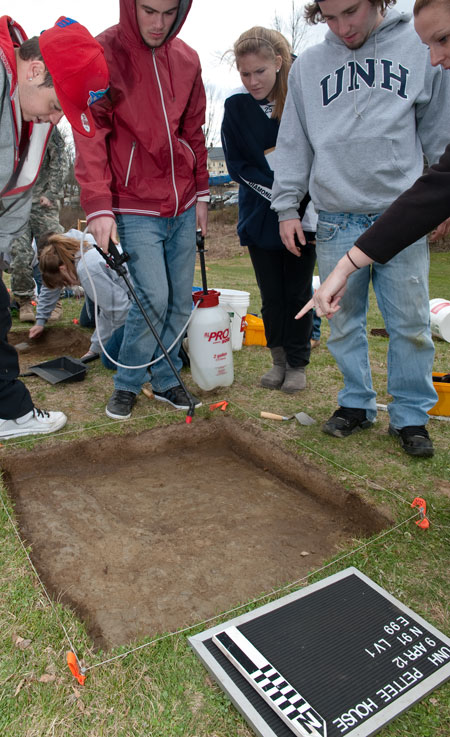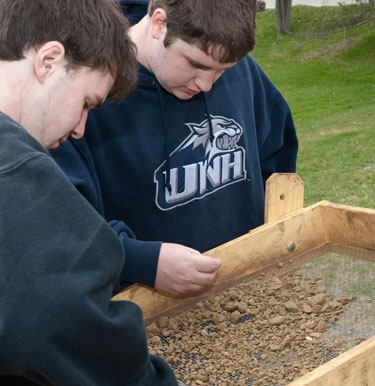|
|
Archaelogy Dig Yields Glimpse of the Past
The Pettee House site will be available for public viewing this Saturday, April 28 from 9 a.m. to 3 p.m.
The site is located next to Garrison Avenue parking lot (across from Stoke Hall). Students will be there to share their findings. Come experience the unearthing of UNH’s history first hand. (Note, children are most welcome but must be accompanied by parents.)
To most passersby, the small, grassy lot catty-corner from Stoke Hall looks like nothing special.
But UNH students in Anthropology 444 know that it holds clues to UNH’s past – and they’ve been working to uncover them this spring by conducting an archeological dig at the now-vacant site that once was home to the late Charles Holmes Pettee, a longtime UNH professor and dean. They will share what they’ve learned this Saturday from 9 a.m. to 3 p.m., when the public is invited to visit the dig across from the intersection of Garrison Avenue and Brook Way.
The students are enrolled in The Lost Campus: The Archeology of UNH, which introduces them to archeology not only through readings and lectures, but also through fieldwork. Taught by Meghan Howey, an assistant professor of anthropology, this Discovery Program Inquiry course marks the first time anyone has conducted an excavation on the UNH campus. It gives the students – most of whom have no experience in the field – a taste of what it’s like to be an archeologist.
“They can actually get their hands dirty and experience it for themselves,” said Kerissa Paquette, a senior anthropology major whom Howey hired to assist with the excavation. “I want them to feel that excitement and that rush of picking up stuff that maybe hasn’t been touched in a hundred years. It’s powerful to think that something was used when there weren’t computers or cell phones. It helps bring you back to that time and realize that life was a lot different even just a hundred years ago.”
|
Charles Holmes Pettee |
The fieldwork is teaching the students about campus life during the late 19th and early 20th centuries, when most faculty members – including Pettee – lived on campus. A professor, dean, and three-time interim president, the Manchester native served the college from 1876 until his death in 1938. His home, which later became the UNH Department of Housing, was demolished in 2007.
Jillian Price, the course’s teaching assistant, said we tend to take for granted the alterations that have occurred on campus. “As soon as buildings are gone, people seem to forget them,” said Price, a junior anthropology and history major. “Digging gives you an idea of how students, faculty and staff have shaped their surroundings.”
|
|
Finding Lost Fragments
On a recent chilly Monday, the students – mostly freshmen and sophomores from a variety of majors – worked in teams to dig pits in a grid-like pattern. Using a trowel, Megan Roed scraped away earth to reveal a jagged fragment of white ceramic, roughly the size of a key. She switched to a brush to sweep dirt from around the fragment before gently removing it. “It’s mind boggling to think that this ceramic piece belonged to someone else and that we’re finding it and learning about it today,” said Roed, a first-year neuroscience and behavior major who was participating in a dig for the first time. “You don’t think that there’s going to be ceramics and old household items under the ground. You don’t think about it when you walk by.”
The site was discovered by class member Josh Beaucher, who was walking home from campus when he noticed an overgrown walkway that abruptly ended. “It led to nowhere,” said the junior anthropology major. “That led me to start asking questions about what was here before.” Beaucher learned from the University Archives that Pettee had lived on the site. Working in groups, students identified 14 other potential locations by conducting archival research in UNH’s Special Collections, including reading newspaper articles, examining photos, and scrutinizing maps. The class chose the Pettee House site after its test excavations in late March yielded a promising mix of artifacts: pearlware (early ceramic), a large brick, nails, glass, and a 1918 penny.
The following week, their first full afternoon of digging revealed part of the foundation of the Pettee House. “It’s beautiful,” Howey told the students as she examined the feature. “This is some kind of retaining wall.”
There’s a lot more to archeology than digging, though. At the site, students drew scale-maps of their pits, showing where they found artifacts, and took photos. They also kept careful records of the objects they unearthed.
Beaucher emptied a pail of dirt onto a screen and sifted through it to capture small artifacts his team had missed. He’s wanted to be an archeologist since he was 12 and sees the work as a quest to rediscover the past. “Even something as simple as a foundation can tell you how they built houses back then,” he said. “Archeologists get excited about the littlest things.” Added Price: “You can feel a connection to the people who were here. It’s not just some house that had no impact at all.”
Read more about the project on the classes’ Twitter and Facebook pages.
Written by Sonia Scherr ’13 MFA
















































